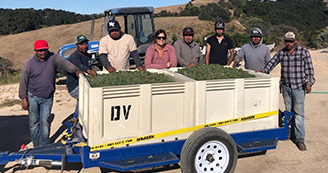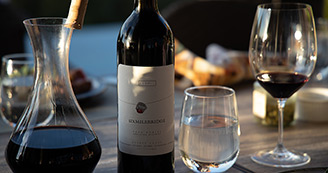Smell Test

Ok. Now you have a glass of wine in your hand. What do you do?
First, swirl it a bit to aerate the wine and bring out its “aromas” if it’s a young wine or “bouquet” if it’s an older wine. Btw, bouquets are very difficult to describe, so the rest of this is mostly about younger wines, one to three to four years.
Now get your nose into the glass. Not an inch from rim. Right down in the glass. Then, take a few short whiffs.
What do you smell? If you’re drinking our Estate Cuvee, do you smell black cheery, raspberry, mint or cedar ? Or our Paladin, do you smell bright red raspberry, black pepper or clove? If you can identify these smells, then you’re a long way into really appreciating wine for its aromas.
For everyone else, I would suggest a simplified approach. Start with four categories of wine aromas:
- Does the wine have a fruity smell? If so, describe the aroma saying saying “it’s fruity,” (like blueberry, blackberry or raspberry). Fruity wines often include Merlot, Cab Franc Malbec, Zinfandel
- Does the wine have a floral smell? Is so, describe the aroma saying “it’s floral” (like rose or lavender). Examples can be Chardonnay, Sauvignon Blanc, Pinot Noir
- Does the wine have an herbal smell? If so, describe the aroma saying “it’s herbal” (like bell pepper, mint or oregano). Examples can be Cabernet Sauvignon, Merlot, Sauvignon Blanc. Notice I repeated these three wines. This is to make the point that depending on where the varietal is grown, it can display different aromas.
Btw, fresh fruit, flowers and herbs make up about 80% of the aromas you will smell. - Does it have an earthy smell to it? If so, describe the aroma, saying it’s “earthy” (like mushrooms, dusty, wet stone or autumn leaves). Btw, some folks consider an earthy smell to be the opposite of a fruity smell. Can be Syrah, Tempranillo
These four categories are a good place to start because these distinctions are pretty easily identified.
So to get started with identifying the aromas you smell, use the words fruity, floral, herbaceous or earthy. Don’t worry about knowing whether it’s black fruit or red fruit, lily or iris, etc. Just go with HEFF: herbaceous, earthy, fruity or floral.
Where do aromas come from?
Wines are said to have three kinds of aromas: primary, secondary and tertiary.
The primary aromas come the varietal itself and natural factors in the vineyard.
Secondary aromas come from the wine making process: fermentation and aging vessels prior to bottling like oak barrels.
Tertiary aromas come from bottle aging.
Here’s to what your nose knows...and learns.



